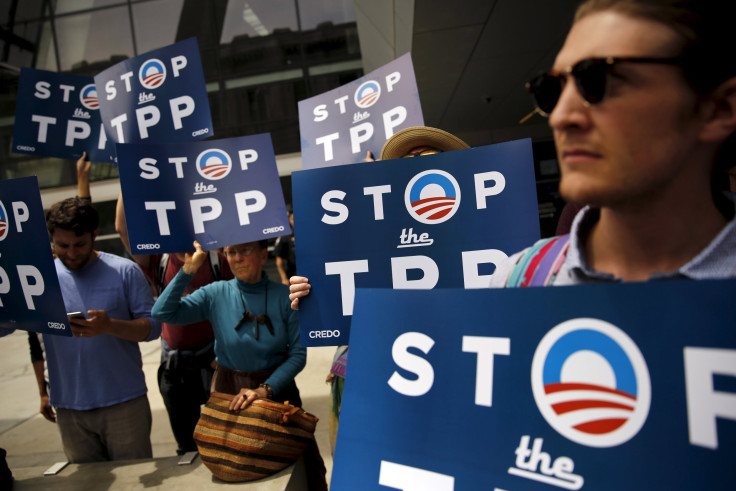What Is The TPP? 5 Things To Know About The Trans-Pacific Partnership

The Trans-Pacific Partnership has become one of the most fundamental issues of the 2016 election, but the trade agreement is still a mystery to most Americans. Despite the fact that both major party candidates vocally oppose the TPP, as it is commonly called, the trade deal is still making headlines.
President Barack Obama continues to advocate for the deal, making it one the starkest points of contrast between him and Hillary Clinton. However, the Democratic nominee's position on the agreement has not always been clear and a recent gaffe by a key ally has the TPP trending once again.
Here are five things to know about the TPP for those who might be playing catch-up:
1. What is It?
The Trans-Pacific Partnership is a controversial trade agreement concerning a group of 12 countries bordering the Pacific Ocean. The countries involved include the United States, Japan, Vietnam, Australia, Malaysia and Chile. The agreement was published for the public in November 2015 after negotiations came to a close in October 2015.
The deal hopes to reduce barriers to trade, including the elimination of certain tariffs, among the participating countries as well as set standards for the ways the countries deal with each other economically. They include stricter labor and environmental rules, legal protections for drug companies and increased copyright protection.
2. Why is it Controversial?
Trade deals are not politically popular right now. The 2016 election cycle has been heavily charged by the dissatisfaction of working class Americans and how politicians have represented their interests over the past few decades.
Businessman-turned-GOP presidential nominee Donald Trump, on the right, and Vermont Sen. Bernie Sanders, on the left, channeled that dissatisfaction over the course of the primary races by blaming trade deals for contributing to companies' opting to outsource jobs, especially manufacturing jobs, to other countries. Both candidates argued that American workers lost out by being forced to compete with the low wage workers in other countries. As a result, trade deals have developed a stigma over the last year and the TPP is falling victim.
3. Does Hillary Clinton Support It?
While serving as Secretary of State, as the TPP was still being negotiated, Clinton said the agreement would "set the gold standard for trade deals." But in October, during a debate with Bernie Sanders, Clinton reversed her position and said the finished deal did not meet her standards.
"I did say, when I was secretary of state, three years ago, that I hoped it would be the gold standard," Clinton said at the time. "It was just finally negotiated last week, and in looking at it, it didn't meet my standards. My standards for more new, good jobs for Americans, for raising wages for Americans. And I want to make sure that I can look into the eyes of any middle-class American and say, 'This will help raise your wages.' And I concluded I could not."
However, many have accused Clinton of only switching her position to court working class voters for the election — Obama still supports the agreement, as has Clinton's running mate, Virginia Sen. Tim Kaine. Those suspicions were stoked this week when Virginia Gov. Terry McAuliffe, a longtime Clinton ally, suggested in an interview Tuesday with Politico that Clinton would reverse her position again if elected.
"I worry that if we don't do TPP, at some point China's going to break the rules, but Hillary understands this. Once the election's over and we sit down on trade, people understand a couple things we want to fix on it, but going forward we got to build a global economy," McAuliffe said, adding, "Listen, [Clinton] was in support of it. There were specific things in it she wanted fixed."
The Clinton campaign has rebuked the suggestion, insisting that Clinton remains opposed to the agreement.

4. Does it Have Benefits?
Proponents argue that the TPP would help raise incomes and exports, though not the number of actual jobs, in the United States. The deal would eliminate tariffs on imports, making certain goods cheaper, reform labor and environmental standards for workers in participating countries and lift restrictions on service jobs within the participating countries — this would allow finance, education and legal professionals, among others, to more freely find work abroad or service international clients. The agreement is intended to help strengthen the United States' relationship with its Pacific Rim allies.
5. What is the Status of the TPP?
President Obama was given "fast track" authority by Congress in June 2015, allowing ratification of the agreement to be handled in a simple up-or-down vote. However, the political climate has derailed Congressional support for the deal and Obama is still waiting on that vote from Congress. Depending on the newly elected president this fall, it may never come.
© Copyright IBTimes 2024. All rights reserved.






















